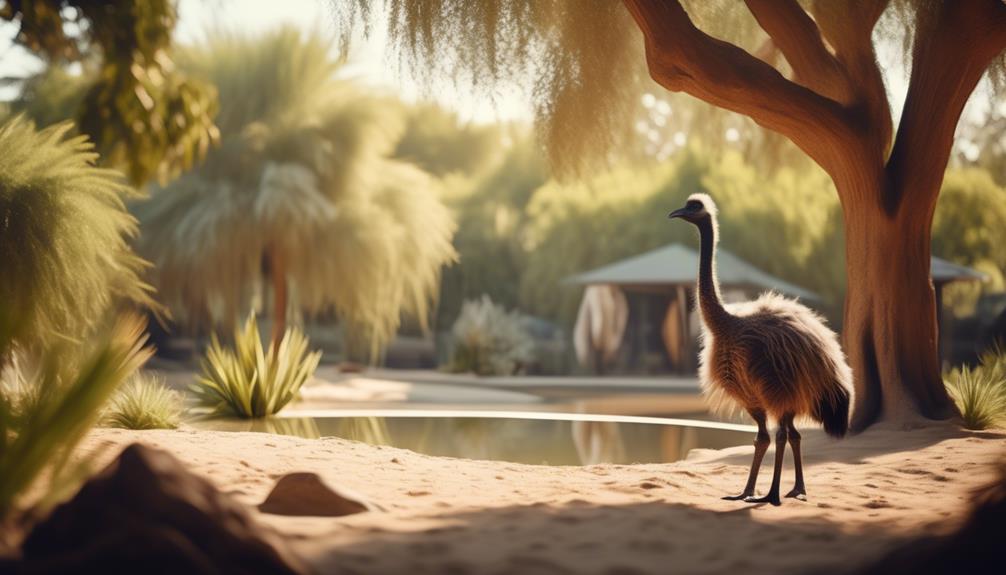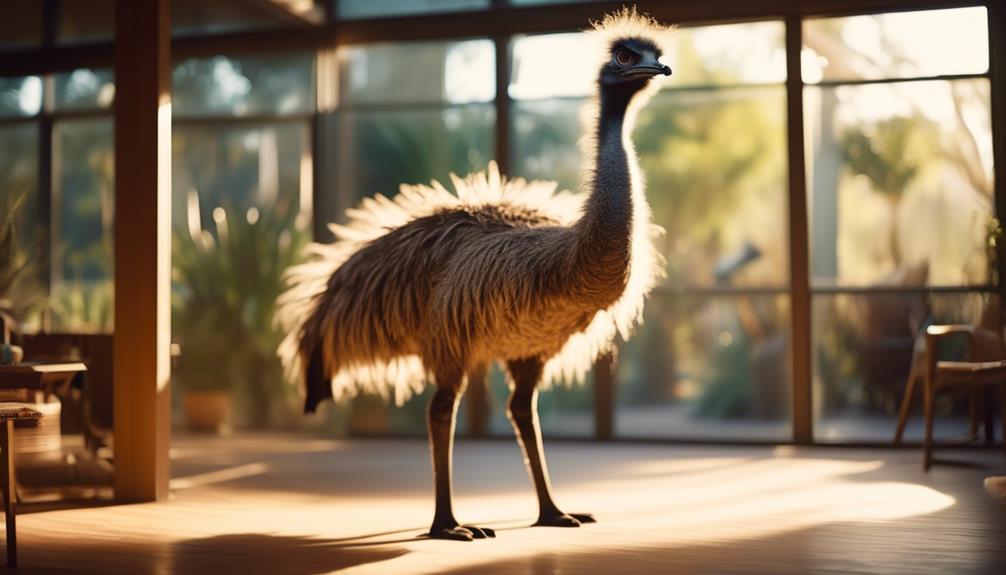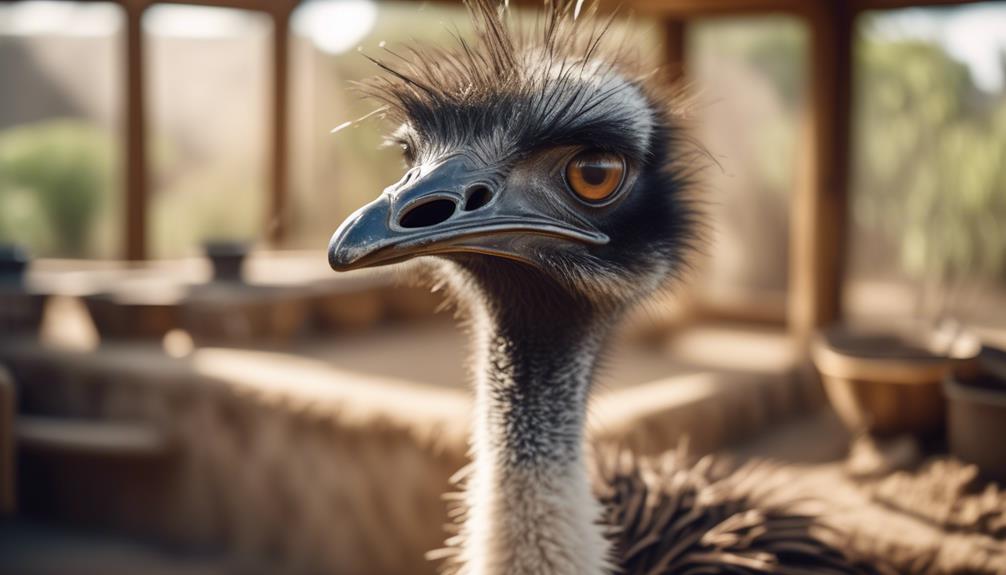
Are you tired of your emu feeling cramped and dissatisfied in its current habitat? It's time to take things to the next level and create the perfect environment for your feathered friend.
By providing ample space, suitable shelter options, and a clean and hygienic environment, you can ensure that your emu thrives in its new home. But that's not all! There are other crucial factors to consider, such as ventilation, temperature control, water sources, and suitable vegetation for grazing.
So, if you're ready to give your emu the ideal habitat it deserves, keep reading to discover the secrets to creating the perfect emu haven.
Key Takeaways
- Emus require a diverse range of food sources, including grass, seeds, fruits, insects, and small vertebrates, within their habitat.
- Access to fresh water for drinking and bathing is essential for emus.
- Suitable nesting areas are needed for protecting the eggs and male emu during breeding season.
- Emus prefer well-drained soil, a moderate climate without severe temperature fluctuations, and avoid high humidity levels.
Understanding Emu Habitat Requirements

Understanding the specific habitat requirements of emus is crucial for creating an optimal environment for these unique and fascinating birds. Emus have distinct feeding habits and breeding patterns that need to be taken into consideration when designing their habitat.
Emus are omnivores, which means they eat both plants and animals. Their diet mainly consists of grass, seeds, fruits, insects, and small vertebrates. Providing a diverse range of food sources within their habitat is essential to ensure their nutritional needs are met. Emus also require access to fresh water for drinking and bathing, so including a water source such as a pond or trough is important.
When it comes to breeding, emus are polygamous, meaning that one male mates with multiple females. During breeding season, which typically occurs in the cooler months, emus form small groups called 'breeding pairs.' The female lays several large green eggs in a communal nest, and it's the male's responsibility to incubate them. Therefore, it's essential to provide suitable nesting areas that offer protection and privacy for the eggs and the male emu.
Selecting the Right Location
To ensure the optimal habitat for emus, careful consideration must be given to selecting the right location that meets their specific needs and requirements. The location you choose will play a crucial role in providing the emus with a suitable environment where they can thrive and live happily. When selecting the perfect spot for your emu habitat, there are two key factors to consider: soil composition and climate considerations.
Firstly, let's take a look at soil composition. Emus prefer well-drained soil that is not too sandy or too clayey. They thrive in areas with loamy soil that allows for sufficient water drainage. Emus also require access to vegetation, so the soil should be fertile enough to support plant growth. Additionally, the soil should not be too acidic or alkaline, as it can affect the emus' health and well-being.
Next, climate considerations are essential when choosing the right location for your emu habitat. Emus are native to Australia and are adapted to its unique climate. They can tolerate a wide range of temperatures, but extreme heat or cold can be detrimental to their health. It is important to select a location with a moderate climate, avoiding areas with severe temperature fluctuations or high humidity levels.
Consider the following table for a quick reference guide on selecting the right location for your emu habitat:
| Soil Composition | Climate Considerations |
|---|---|
| Well-drained | Moderate temperature |
| Loamy | Avoid extreme heat or cold |
| Fertile | No severe temperature fluctuations |
| Neutral pH | Moderate humidity levels |
Determining the Ideal Space Size

Determining the ideal space size for your emu habitat requires careful consideration of their natural behavior and physical needs. These fascinating creatures need ample space to roam and exercise, so providing them with a large enclosure is essential. Emus are known for their ability to run at high speeds, reaching up to 30 miles per hour, so it's crucial to create an environment that allows them to stretch their legs.
In terms of space requirements, a minimum of one acre is recommended for a pair of emus. This gives them enough room to move freely and engage in their natural behaviors, such as foraging and socializing. However, if you have the means, providing them with even more space is highly beneficial. Emus thrive in large, open areas where they can explore and exhibit their natural instincts.
Creating a stimulating environment within the emu habitat is also important. Emus are curious creatures that enjoy exploring their surroundings. By incorporating various structures, such as logs, rocks, and shrubs, you can create a diverse landscape that offers opportunities for mental and physical stimulation.
Additionally, providing them with plenty of shade, water sources, and sheltered areas is crucial for their overall well-being.
Choosing the Best Shelter Options
When it comes to providing the best shelter options for your emus, it's crucial to consider their specific needs and natural instincts. Emus require a shelter that's both comfortable and secure, allowing them to rest and seek protection from the elements.
Here are some important factors to consider when choosing the best shelter options for your emus:
- Shelter materials: Emus prefer shelters made of sturdy materials such as wood or metal. These materials provide durability and protection against predators. Avoid using materials that could harm the emus, such as sharp edges or toxic substances.
- Shelter size: Emus need enough space to move around comfortably inside their shelter. A shelter that's too small can cause stress and restrict their natural behaviors. Ensure the shelter is spacious enough to accommodate the emus' size and allow them to spread their wings.
- Shelter customization options: Providing customizable features in the shelter allows you to adapt it to the specific needs of your emus. Consider options such as adjustable ventilation, removable partitions, and nesting areas. These customization options help create a comfortable and adaptable environment for your emus.
- Shelter location: Choose a shelter location that offers protection from the wind, rain, and extreme temperatures. Ensure the shelter is well-drained and placed on higher ground to prevent flooding. Additionally, consider placing the shelter in a quiet area away from potential disturbances or noise.
Providing Proper Ventilation and Temperature Control

Proper ventilation and temperature control are crucial factors to consider when creating the perfect emu habitat.
Ventilation benefits the emus by providing fresh air, removing excess moisture, and preventing the buildup of harmful gases. To ensure adequate ventilation, provide windows or vents that allow for the circulation of fresh air. This will help maintain a healthy environment by preventing the accumulation of odors and reducing the risk of respiratory problems in your emus. Additionally, by controlling the humidity levels, you can prevent the growth of mold and bacteria, which can be harmful to the birds.
Emus are sensitive to heat, so it's important to implement temperature control techniques in their habitat. Temperature control is equally important. Emus are native to Australia, where they're accustomed to hot climates. However, extreme heat can still be detrimental to their health. Consider installing fans or misters to keep the temperature at a comfortable level. You can also provide shaded areas for the emus to retreat to during the hottest parts of the day.
Designing an Appropriate Flooring Surface
To ensure the overall comfort and well-being of your emus, carefully selecting an appropriate flooring surface is a crucial aspect of creating their ideal habitat. Emus spend a significant amount of time on their feet, so the flooring material you choose should provide cushioning and support. Here are some essential considerations for designing the perfect flooring surface for your emus:
- Rubber mats: Provide a soft and slip-resistant surface that's easy on the emus' joints and feet.
- Grass or dirt: Mimics their natural habitat and allows for natural foraging and scratching behaviors.
- Concrete: While not as comfortable as rubber mats or natural surfaces, concrete is durable and easy to clean.
- Sand: Offers a soft, natural surface that encourages digging and dust bathing.
When it comes to cleaning the flooring surface, regular maintenance is key to ensuring hygiene and preventing the buildup of bacteria or parasites. Here are some cleaning methods to consider:
- Sweeping: Remove loose debris and feathers daily to maintain cleanliness.
- Hosing: Use a hose to wash away dirt and feces regularly.
- Disinfection: Use a disinfectant recommended for use with animals to sanitize the flooring surface periodically.
Ensuring Ample Natural Lighting

One crucial factor in creating the perfect emu habitat is ensuring that there's ample natural lighting available. Emus, like many animals, rely on natural light to regulate their daily activities and maintain their overall health. By maximizing feeding opportunities and enhancing natural behaviors, proper lighting can play a significant role in creating a comfortable and stimulating environment for your emus.
When it comes to natural lighting, it's essential to provide a habitat that allows plenty of sunlight to enter. Emus are diurnal creatures, meaning they're most active during the day. By allowing natural light to flood their living space, you aren't only providing them with a sense of familiarity but also encouraging their natural habits.
In addition to promoting their natural behavior, ample natural lighting can also aid in maximizing feeding opportunities. Emus need proper visibility to locate and consume their food. By ensuring that their habitat is well-lit, you're helping them find their food more easily and maintain a healthy feeding routine.
To enhance natural lighting in your emu habitat, consider positioning their enclosure in an area that receives plenty of sunlight throughout the day. Additionally, make use of windows or skylights to allow natural light to enter their living space. By doing so, you're creating an environment that's conducive to their well-being and natural instincts.
Incorporating Water Sources
In order to create a well-rounded and thriving emu habitat, it's crucial to incorporate a variety of water sources. Water management plays a vital role in maintaining the health and happiness of your emus. By providing ample water sources, you not only ensure their hydration but also attract wildlife to the area, enriching the overall ecosystem.
Here are four ways to incorporate water sources into your emu habitat:
- Ponds and Lakes: Digging a pond or creating a small lake in your emu habitat can provide a natural water source for your emus. Ensure the water is clean and fresh by regularly monitoring and maintaining it.
- Mud Puddles: Emus love to wallow in mud to cool off and protect themselves from pests. Creating mud puddles in strategic areas of the habitat will allow your emus to engage in their natural behavior.
- Bird Baths: Installing bird baths will attract not only emus but a variety of other bird species as well. Ensure the baths are shallow and regularly replenished with fresh water.
- Rainwater Collection: Setting up rainwater collection systems can provide a sustainable water source for your emus. This method also helps conserve water and reduces your ecological footprint.
Selecting Suitable Vegetation for Grazing

When selecting suitable vegetation for grazing in your emu habitat, it's important to consider their dietary needs and preferences, as well as the overall ecosystem balance. Emus are herbivorous birds that have specific grazing patterns and preferences. They primarily feed on grasses, leaves, fruits, and seeds. To ensure a balanced diet, it's crucial to provide a variety of plant species in their habitat.
When choosing vegetation for your emus, consider their grazing patterns. Emus tend to graze by pecking at plants and stripping leaves, rather than cropping grass close to the ground like other grazing animals. Therefore, it's important to select vegetation that can withstand this type of grazing behavior.
Another important factor to consider is soil fertility. Emus require a nutrient-rich diet to maintain their health and vitality. Therefore, it's essential to choose plant species that grow well in fertile soil and can provide the necessary nutrients for the emus.
Some suitable vegetation options for emus include native grasses such as kangaroo grass, wallaby grass, and weeping grass. These grasses are hardy and can withstand the grazing patterns of emus. Additionally, including shrubs and trees like acacia, eucalyptus, and casuarina can provide additional food sources and shade for the emus.
Implementing Secure Fencing Solutions
To ensure the safety and security of your emus as they graze on the carefully selected vegetation, it's essential to implement a robust and reliable fencing solution within their habitat. Emus are curious and resourceful creatures, capable of exploring and potentially escaping their designated area if not properly contained. Here are some key considerations for a secure fencing installation:
- Choose the right materials: Opt for sturdy materials such as chain-link or woven wire fencing that can withstand the emus' strength and prevent them from squeezing through or breaking the fence.
- Determine the appropriate height: Emus are tall birds, capable of reaching heights of up to 6 feet. Ensure the fencing is high enough to discourage them from attempting to jump over it.
- Reinforce the bottom of the fence: Emus are known for their powerful legs, so it's crucial to bury the bottom of the fence several inches into the ground to prevent them from digging under it.
- Install predator deterrents: Emus are vulnerable to predator attacks. Consider adding electric fencing or predator-proof mesh to further reinforce the security of the enclosure.
Maintaining a Clean and Hygienic Environment

Maintaining a clean and hygienic environment is crucial for the health and well-being of your emus, ensuring their optimal growth and minimizing the risk of disease transmission. To keep your emu habitat clean, it's essential to implement effective pest control methods and have a proper emu waste management system in place.
When it comes to pest control, regularly inspect your emu habitat for signs of infestations such as insects or rodents. Install mesh screens on windows and doors to prevent entry of pests, and seal any cracks or crevices that may serve as entry points. Consider using natural pest deterrents like citronella or neem oil, which are safe for emus and help keep pests at bay.
Emu waste management is also important in maintaining a clean environment. Emus produce a substantial amount of waste, so it's crucial to have a system in place to handle it. Regularly clean and remove waste from the habitat to prevent the buildup of harmful bacteria and odors. Consider using absorbent bedding materials, like straw or wood shavings, to help manage waste and absorb moisture.
Frequently Asked Questions
Can Emus Be Kept as Indoor Pets?
Emus can be kept as indoor pets, but it's important to provide them with proper housing. Indoor emu housing should include a spacious area for them to roam and exercise, along with access to fresh air and natural lighting. Emus can also be used as therapy animals, offering comfort and companionship.
What Is the Average Lifespan of an Emu in Captivity?
Emus, like all animals, have varying lifespans in captivity. On average, they can live up to 20 years. However, it is important to address common health issues to ensure their well-being and longevity.
Do Emus Need a Specific Type of Soil for Their Habitat?
Emus thrive in habitats with well-drained soil, but they don't require a specific type. To create a perfect habitat, incorporate plants like grasses and shrubs that provide food and cover. Don't forget to provide shade for their enclosures to keep them comfortable.
Can Emus Be Housed With Other Bird Species?
When considering housing compatibility for your emu, it's important to understand their social behavior. Emus are best housed with other emus or similar-sized bird species, as they can become aggressive towards smaller birds.
How Often Do Emus Need to Be Bathed or Groomed?
Emus should be bathed every few months, or as needed, to keep their feathers clean and healthy. Grooming techniques include trimming nails and beak, checking for mites, and brushing feathers to remove dirt and debris.
Conclusion
Congratulations! You now have the expertise to create the ultimate paradise for your emu.
By understanding their habitat requirements, selecting the perfect location, providing suitable shelter and vegetation, and maintaining a clean environment, you'll ensure your emu feels like it's living in a luxurious oasis.
So go ahead and unleash your inner emu whisperer, and watch as your feathered friend thrives in its new perfect habitat.


